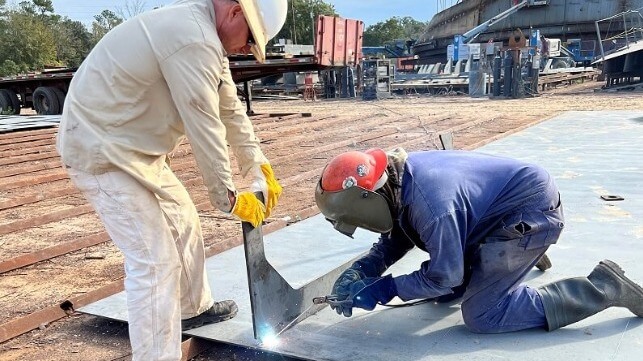Construction of Crowley's All-Electric Tug Begins

Master Boat Builders announced Thursday that its Alabama-based shipyard has begun construction of Crowley Maritime's eWolf, the first all-electric ship assist tug in the United States.
"Initiating construction of the first-ever fully electric U.S. tugboat, the eWolf marks a historic moment for Crowley and Master Boat Builders,” said Garrett Rice, president of Master Boat Builders. “Today is also a remarkable milestone for the entire U.S. maritime industry, as we work toward providing groundbreaking net zero-emission maritime capabilities”.
The 82-foot harbor tug is being developed in partnership with federal and California state agencies, and it is expected to enter service in mid-2023 at the Port of San Diego. It is designed to operate on batteries alone, with no emissions, at full power. In operation, it will provide up to 70 short tons of bollard pull using a 1,800 kW azimuthing drive propulsion system and a 6-MWh battery pack.
The platform is designed for the flexibility to carry out later adjustments, and fully modular batteries allow for upgrades as technology changes. In addition, Crowley has developed an onshore charging station for the tug's home port infrastructure. ABB is providing its electrical package, and Crowley's in-house naval architecture division is providing the design and construction supervision.

that matters most
Get the latest maritime news delivered to your inbox daily.
Crowley recently announced a commitment to reach zero emissions in its operations and its full value chain by 2050 - including all emissions from its own operations (Scope 1) and emissions from its counterparties (Scope 2 and 3). Crowley says that reaching this target will take an emissions cut of 4.2 million metric tons of greenhouse gas per year. This would be the equivalent of removing more than 900,000 cars from the road.
“Crowley is on a mission to become the most sustainable and innovative maritime and logistics company in the Americas,” said Tom Crowley, the firm's chairman and CEO. “Working together with our customers, suppliers, policymakers and others across our value chain, we can meet the climate crisis head on.”
